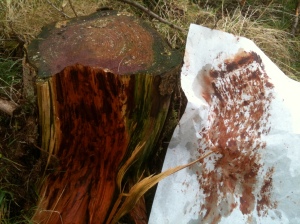Mucking About with Art Materials
May 31, 2011
LANDMARKS: NATURE, ART, SCHOOLS
Week 12 -18 New Participants, St. Finian’s National School, 20 New Participants Monastery National School
Total Individual Children Participants: 247
Total Participation of Children: 447 (Some school classes have returned 2-3 times)
“Pamela had the children in the palm of her hand. As soon as we walked into the “studio” there was so much inspiration, so many things catching the eye. The central display was extremely expressive, I thought at first that it might be distracting when Pamela was talking, but she used the pictures very effectively. The children had to search for samples of artist’s work and show them to others. All the activities were simple yet exciting and interesting. She orchestrated the children to develop their work offering suggestions yet encouraging their own creativity. An enjoyable experience for all the children and an inspiring lesson for me as a teacher (St. Finian’s National School Principal) 
A recent article in Heritage Outlook: The Magazine of the Heritage Council of Ireland (Summer, 2011) called “Running Free: The Importance of Children Enjoying the Outdoors” by Isabell Smyth discusses the effects of children’s participation within nature. She stresses the importance of “mucking about,” as an opportunity for children to explore the wonder of the world in which they are part. Mucking about outdoors, is not about built playgrounds, it is rather a free exploration of landscape and nature. The materials of the natural world – the earth, stones, sticks, trees, flowers, and water – that engage a child’s senses also inspire a child’s creativity. It can be argued that these natural elements are an entry into the world of land artists, the simplicity of observation, collecting, and building are inherent within nature play and art.
Within the Landmarks project, mucking about with mud, creating prints from trees, stones, pine cones and leaves and working with charcoal (gathered from abandoned campfires) layer textures within children’s artwork. Children are encouraged to work instinctively in the ‘rough.’ The importance of engaging a sense of freedom, and working physically with natural materials, brings feeling and sensation to children’s art.
To the right a photo showing a ‘wood cut’ print, which inspired the printmaking from wood, stones, leaves, etc. with children in Landmarks. There is also a photo of the Malone Room, Ardee Library the ‘studio’ for Landmarks.

The Language of Landmarks and Landscape
May 9, 2011

 LANDMARKS: NATURE, ART, SCHOOLS
LANDMARKS: NATURE, ART, SCHOOLS
Week 11 – 18 New Participants
Total Individual Children Participating: 209
Total Participation of Children: 409 (Some school classes have returned 2-3 times)
“A wonderful, magical
 experience in a back-to-nature environment. The children enjoyed a hands-on experience, and it was a great opportunity for creative and artistic expression. I loved the bird song! A chance to see and experience the wonder and beauty of art in nature and the natural environment. The resources and materials were fantastic. Thanks so much, more please!” St. Finian’s National School (Dillonstown), Teacher (3rd/4th Class).
experience in a back-to-nature environment. The children enjoyed a hands-on experience, and it was a great opportunity for creative and artistic expression. I loved the bird song! A chance to see and experience the wonder and beauty of art in nature and the natural environment. The resources and materials were fantastic. Thanks so much, more please!” St. Finian’s National School (Dillonstown), Teacher (3rd/4th Class).
The advantage of children working in a studio setting is the freedom to explore layers of instinctive marks (made with pencils, pastels, charcoal, and paint) that in essence compose a child’s own language of expression. Many drawings, words, and painted textures can be applied to sculpted paper books, so that a child creates their own landscape of identity.
Each child has a distinctive approach to their artworks and creative writing. Collecting words and impressions from natural materials, while also drawing inspiration from artists who work with nature fuels imagination. Engaging with nature, “supports a child’s sense of self, allowing children to recognise their independence alongside an interdependence and connectedness with their ecological worlds” (Play Naturally: A Review of Children’s Natural Play by Stuart Lester and Martin Maudsley, included in the Children and Nature website http://www.childreandnature.org under Research and Publications).
Experimentation within a studio environment is an invitation for children to follow their own path of discovery. The artwork is never really finished, always a “work-in-progress,” a journey in the making. “Among the many relationships that define the human condition, the individual’s connection to the environment is primary…We singular creatures… aspire to leave our mark, inscribing our observations and gestures within the landscape, attempting to translate and transgress the space within which we find ourselves (J. Kastner and B. Wallis Land and Envrionmental Art).
For children inscribing their lives within both art and nature reflects who they are within the greater canvas of the world-at-large. An empathic kinship with nature offers sensory, perceptual, and emotional opportunities for communication. For children this can be a vital source of expression, a declaration in their own artistic language.
A Collection of Words from the Landmarks Studio:
Wool wrapped up in a basket
Sticks with seaweed too
Stones and rocks all piled up as one
Shields of sticks and branches
A vase of flowers
Wide open pinecones
(Written by a student of St. Finian’s National School (Dillonstown), 3rd/4th class)
The photos show small folded paper books, suspended bundles of wool, three-dimensional willow shapes, drawings and collages displayed within the Malone Room of the Ardee Library, County Louth.